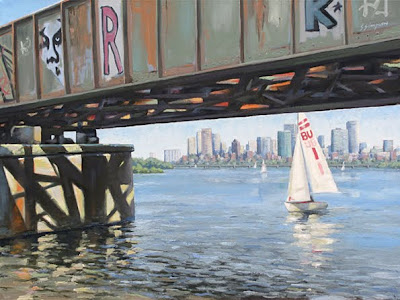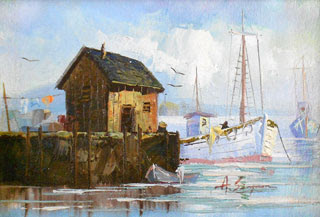
I was standing in line at the post office the other day and was checking out the new stamps in the case on the wall. I've been to the desert southwest several times and I love the area, so a new stamp of the New Mexico desert caught my eye. I thought I might buy one and frame it as a mini art object. I get these odd ideas sometimes.
Well, the woman ahead of me in line was taking forever, so I had lots of time to study this stamp. My painters eye switched on and I started picking apart the composition. I apologize to the artist because it's really a beautiful stamp and criticism is cheap and it's kinda shitty for one artist to pick another's work apart, but I can't help myself!
I'm prone to copying nature too religiously. I know this about myself. I have to force myself when painting to think, "How can I improve on this view of Nature?" Some may think that nature is so wonderful and awe-inspiring, who am I to change what I see when I craft a painting of it? We must remember that art is a totally man-made thing. Nature doesn't try to look beautiful, we decide that a certain view is beautiful and record it in a way that pleases us. One thing that I make a conscious effort to keep from my paintings is repetition. When two objects are the same size in an image, our brains, which are constantly looking for patterns and similarities, latches on to this and gives it significance. Nature is random, so, a painting of nature that presents repetition that is exact makes the painting look, um, unnatural.
This stamp shows two buttes. The one on the left is obviously farther away than the one on the right. But, in the original stamp the butte on the right is almost exactly the same size. To make matters more difficult, the bush at lower right is also the same size as the buttes! Now, this scene may be accurate to what you would see if you stood in that spot, but, why would you choose to represent this? Since I can't help myself (and I know a good deal of Photoshop) I have edited this image to demonstrate how I hope I would have interpreted this scene if I were to paint on this spot in the desert.
Original:

Edited:
 Here, I have enlarged the closest butte and pushed its head up through the clouds behind. This dramatically improves the perspective of the scene. It's really important because the foremost butte is lighter than the farther one. Colors are generally darker and more saturated the closer you are to them. I've shrunk the shrub at lower right to subordinate it to the buttes and prevent it from competing with the buttes scale-wise..
Here, I have enlarged the closest butte and pushed its head up through the clouds behind. This dramatically improves the perspective of the scene. It's really important because the foremost butte is lighter than the farther one. Colors are generally darker and more saturated the closer you are to them. I've shrunk the shrub at lower right to subordinate it to the buttes and prevent it from competing with the buttes scale-wise..I don't want to take away anything from the artist. I love this image, and it could be that he represents the scene accurately. But, if the aim is to make a pleasing picture (using one's artistic license) then you should be conscious of these relationships in your work and actively seek to make better paintings by mitigating them. Otherwise, you might as well become a photographer.







